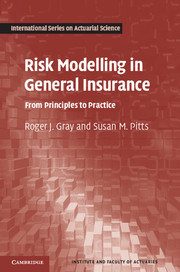Book contents
- Frontmatter
- Contents
- Preface
- 1 Introduction
- 2 Models for claim numbers and claim sizes
- 3 Short term risk models
- 4 Model based pricing – setting premiums
- 5 Risk sharing – reinsurance and deductibles
- 6 Ruin theory for the classical risk model
- 7 Case studies
- Appendix A Utility theory
- Appendix B Answers to exercises
- References
- Index
6 - Ruin theory for the classical risk model
Published online by Cambridge University Press: 05 August 2012
- Frontmatter
- Contents
- Preface
- 1 Introduction
- 2 Models for claim numbers and claim sizes
- 3 Short term risk models
- 4 Model based pricing – setting premiums
- 5 Risk sharing – reinsurance and deductibles
- 6 Ruin theory for the classical risk model
- 7 Case studies
- Appendix A Utility theory
- Appendix B Answers to exercises
- References
- Index
Summary
In Chapter 3 we considered risk models for a fixed time period. Now we widen our focus and consider risk models that evolve over time. Our basic model, the classical risk model, is introduced in §6.1, and in this chapter our aim is to study ruin theory for this model. Ruin theory is concerned with quantities related to the event that the insurance company's capital becomes negative at some point in time. These ruin quantities are defined in §6.1 and §6.2, and their properties and behaviour are studied in later sections of this chapter. Numerical calculation of, and statistical inference for, these ruin quantities are discussed in §6.6 and §6.7.
The classical risk model
We aim to build a time-evolving risk model that captures the evolution of the reserves of an insurance company. We follow the principle of putting together separate models for the arrivals of claims and for the claim sizes, an approach that we found to be useful and tractable in Chapter 3. In addition we incorporate an extra ingredient describing the inflow of premium income.
In the classical risk model we assume the following.
(i) The claim sizes X1, X2, … are iid positive random variables with distribution function FX and finite mean μ.
(ii) The claims arrive in a Poisson process with rate λ (>0).
(iii) The claim sizes X1, X2 … are independent of the claim-arrival process.
(iv) Premium income accrues linearly in time at rate c (>0), so that by time t the total amount of premiums received is ct.
(v) At time t = 0 the insurance company has (non-negative) initial capital u.
- Type
- Chapter
- Information
- Risk Modelling in General InsuranceFrom Principles to Practice, pp. 267 - 315Publisher: Cambridge University PressPrint publication year: 2012



